 W
WThe Academy Palace is a neoclassical palace in Brussels, Belgium. It is situated on Rue Ducale/Hertogstraat, next to the Place des Palais/Paleizenplein, the Royal Palace of Brussels and Brussels' Park. Today, it houses five Belgian academies including the Royal Academies for Science and the Arts of Belgium. In English, the Academy Palace is also often called the Academy House.
 W
WBelgian beer culture includes traditions of craftsmanship for brewing beer and is part of the diet and social life of Belgians. Its cultural value was formally recognised in 2016 when it was added to UNESCO's "Intangible Cultural Heritage of Humanity" list.
 W
WBelgian National Day is the national holiday of Belgium commemorated annually on 21 July. It is one of Belgium's ten public holidays and marks the anniversary of the investiture of King Leopold I, the country's first monarch, in 1831.
 W
WBelgitude is a term used to express the Belgian soul and identity.
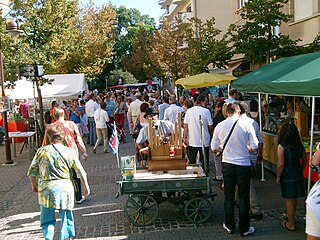 W
WA braderie or jaarmarkt is a type of grand yearly street fair and street market found in the Netherlands, Belgium, Luxembourg and Northern France, mostly held in the summer months.
 W
WDruon Antigoon or Druon Antigonus is a Flemish folkloric character. He was a mythical giant who lived in Antwerp.
 W
WThe Ducasse d'Ath is a traditional parade held to mark the victory of David over Goliath. It takes place in the town of Ath in Belgium. It has been recognized as one of the Masterpieces of the Oral and Intangible Heritage of Humanity by UNESCO, under "Processional giants and dragons in Belgium and France". The parade is held on the 4th Sunday of August every year and is characterized by the presence of large giants depicting many characters from local history.
 W
WThe sales of fireworks in Belgium is federally regulated. Since 5 July 2017, the sale of European category F3 fireworks to non-professionals is a criminal offence; the non-professional customer needs to be at least 12 years old for category F1 and at least 16 years old for category F2; the vendor is required to verify the customer's age.
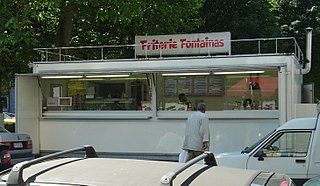 W
WA friture, baraque à frites or friterie in French-speaking Belgium and Northern France, or frituur or frietkot in Flanders and the Netherlands, also fritkot in French-speaking Belgium and friture or frietkraam in the Netherlands, is a traditional restaurant, kiosk or van serving quick-service fast food, particularly fries from which they derive their name.
 W
WThe Carlos de Amberes Foundation is a charitable foundation located in Madrid, Spain. It was founded when Carlos de Amberes donated his goods in 1594 to create a hostel; Carlos was a native of Antwerp, and bequeathed all his property to support people from the Low Countries visiting Spain. The emphasis has now shifted to cultural projects, although the original purpose was assisting pilgrims and people visiting court.
 W
WThe Grote rivieren, literally translated Great rivers, is a landform in the Netherlands. Also, the term is commonly used for a divide in Dutch culture linking to the broader Dutch-Flemish culture.
 W
WHeritage registers in Belgium include immovable heritage such as World Heritage Sites, and National heritage sites, but also intangible cultural heritage. The agency responsible for keeping and updating inventories of immovable heritage is dependent on the region, as is the name for the object, which is called Beschermd erfgoed, Biens classés or Kulturdenkmal depending on the language of the municipality of the location.
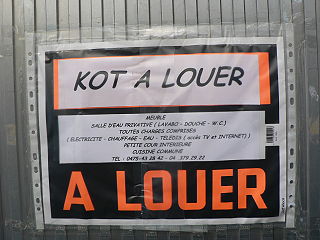 W
WA kot is a type of student housing privately rented during the academic or school year in Belgium. The word kot is used in both Belgian Dutch and Belgian French, but not in standard Dutch or standard French.
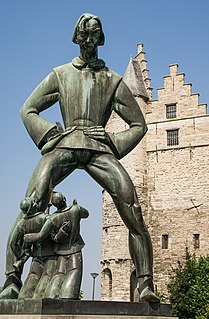 W
WLange Wapper is a Flemish folkloric character. He is a legendary giant and trickster whose folk tales were told especially in the city of Antwerp and its neighbouring towns, but similar tales are also prominent in other Flemish cities.
 W
WManneken Pis is a landmark 61 cm (24 in) bronze fountain sculpture of a puer mingens in central Brussels (Belgium), depicting a naked little boy urinating into the fountain's basin. It was designed by Jérôme Duquesnoy the Elder (1570–1641), and put in place in 1618 or 1619. The current statue is a replica which dates from 1965. The original is kept in the Brussels City Museum. Manneken Pis is the best-known symbol of the people of Brussels. It also embodies their sense of humour and their independence of mind.
 W
WThe Marches of Entre-Sambre-et-Meuse are a set of folk marches, taking place from May to October, in Belgium in Entre-Sambre-et-Meuse. Ancient religious processions dedicated to local saints, protectors of parishes have taken over time a folkloric character, without the religious aspect getting totally lost. They are accompanied by armed escorts, which are just as well traditional.
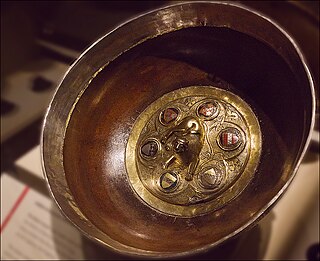 W
WA mazer is a special type of wooden drinking vessel, a wide cup or shallow bowl without handles, with a broad flat foot and a knob or boss in the centre of the inside, known technically as the print or boss. They vary from simple pieces all in wood to those ornamented with metalwork, often in silver or silver-gilt. They use dense impervious woods such as maple, beech and walnut wood. They are a north European medieval tradition, mostly made from the 11th to the 16th centuries. A "mazer" is not someone who makes mead. This is a new and incorrect use of the word, which Ken Schramm has likened to "calling someone who makes beer a mug or a glass."
 W
WStilt jousting is a 600-year-old tradition of the city of Namur, Belgium, in which costumed people on stilts joust.
 W
WThe processional giants and dragons of Belgium and France are a set of folkloric manifestations which have been inscribed by UNESCO on the lists of Intangible Cultural Heritage in 2008, originally proclaimed in November 2005.
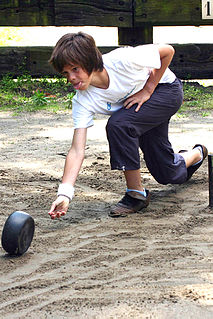 W
WRolle Bolle also known as Belgian Bowling, or Krulbollen in Belgium, is a bowling sport related to boules, which originates from the Flanders region of Belgium. The sport was introduced to North America in the late 19th and early 20th centuries and is played in some rural areas of the Midwest and Prairie regions of the United States and Canada.
 W
WRos Beiaard of Dendermonde is a large folkloristic horse. It differs from the other Ros-Beiaard horses because it is used only once every ten years and because the horse is carried by people. The Ros Beiaard is on UNESCO's list of Masterpieces of the Oral and Intangible Heritage of Humanity, under the "Processional giants and dragons in Belgium and France".
 W
WSinterklaas or Sint-Nicolaas is a legendary figure based on Saint Nicholas, patron saint of children. Other Dutch names for the figure include De Sint, De Goede Sint, and De Goedheiligman. Many descendants and cognates of "Sinterklaas" or "Saint Nicholas" in other languages are also used in the Low Countries, nearby regions and former Dutch colonies.
 W
WThe Société Libre des Beaux-Arts was an organization formed in 1868 by Belgian artists to react against academicism and to advance Realist painting and artistic freedom. Based in Brussels, the society was active until 1876, by which time the aesthetic values it espoused had infiltrated the official Salon. It played a formative role in establishing avant-gardism in Belgium.
 W
WOlivier Strebelle was a Belgian sculptor.
 W
WThe Adventures of Tintin is a series of 24 bande dessinée albums created by Belgian cartoonist Georges Remi, who wrote under the pen name Hergé. The series was one of the most popular European comics of the 20th century. By 2007, a century after Hergé's birth in 1907, Tintin had been published in more than 70 languages with sales of more than 200 million copies, and had been adapted for radio, television, theatre and film.